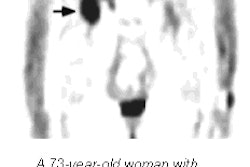CHICAGO - A breast positioning product, based on an idea patented in 1996 by Massachusetts General Hospital in Boston, shows tremendous promise in improving patient comfort as well as providing a greater field of view for imaging. Richard Moore, one of the inventors of the MaxView product, presented results of a study on its use to attendees at the RSNA.
The product, manufactured by Helsinki-based Planmed, consists of a pair of membranes that fit over the compression paddles. The membranes are powered by motors that create gentle traction, further drawing breast tissue into the imaging field of the mammographic unit. The mammographic technologist, via hand controls or foot pedals, controls the direction of the membranes to better position the breast. The MaxView positioning tool has received FDA 510(k) approval for marketing in the U.S.
Moore’s team measured how much of a tissue increase MaxView drew into the field of view, and also solicited comments from the study participants. The study group consisted of 57 women between the ages of 40 and 79 who had two additional images taken of one of their breasts after a standard screening mammogram. The images were taken using the product mounted onto the compression paddles and bucky of a Planmed mammography unit, the Sophie. Both hand and foot pedal controls were available for use by the technologist.
Each volunteer was manually positioned, compressed, and imaged in standard mammographic position by an experienced mammographer. Traction was then applied, without compression release, and the patient was re-imaged.
A skilled, unblinded observer measured 87 image-pairs and recorded feature distance to film-edge into a database. The features used were calcifications, nodes, skin line, and densities. Images were also superimposed over a bright-light until features registered, and then the center film-edge difference was measured for distance and angle.
The feature measurement demonstrated a mean 5.02 mm improvement, and the superposition measurement showed a mean gain of 6.4 mm and 6.0mm. Patient comments as to comfort and satisfaction with the traction device were varied; however, neutral-positive comments outnumbered negative comments by a 27 to 12 ratio.
Most neutral-positive comments noted that the compression-discomfort of the system was separate and was not increased by traction. Some of the patient comments reported by the research team said that some subjects believed that the traction "relieved" discomfort.
"We recorded no abrasion or breaking of the skin with the use of the product," said Moore in response to an audience question about traction sensitivity. "The membranes absorb the force of traction over the bucky."
By Jonathan S. Batchelor
AuntMinnie.com staff writer
November 29, 2001
For the rest of our coverage of the 2001 RSNA meeting, go to our RADCast@RSNA 2001.
Copyright © 2001 AuntMinnie.com



















